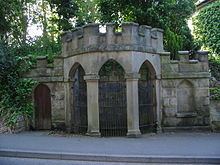 | ||
Similar Dunorlan Park, Bayham Old Abbey, Marle Place Gardens, Groombridge Place, Bewl Water | ||
What does chalybeate mean
Chalybeate /kəˈlɪbiː.eɪt/ waters, also known as ferruginous waters, are mineral spring waters containing salts of iron.
Contents
- What does chalybeate mean
- Chalybeate spring st jame s garden liverpool
- Name
- History
- Content of the chalybeate waters from Tunbridge Wells
- Notable chalybeate springs
- Places named for chalybeate springs
- References
Chalybeate spring st jame s garden liverpool
Name
The word "chalybeate" is derived from the Latin word for steel, "chalybs", which follows from the Greek word χάλυψ khálups. Khálups is the singular form of Khálubes or Chalybes, who were mythical people living on Mount Ida in north Asia Minor who had invented iron working.
Ferruginous /fəˈruːdʒᵻnəs/ comes from the Latin word "ferreus" meaning "made of iron," which is derived from the Latin word "ferrum" which means "iron."
History
Early in the 17th century, chalybeate water was said to have health-giving properties and many people have promoted its qualities. Dudley North, 3rd Baron North discovered the chalybeate spring at Tunbridge Wells in 1606. Dudley North’s physician claimed that the waters contained ‘vitriol’ and the waters of Tunbridge Wells could cure:
"the colic, the melancholy, and the vapours; it made the lean fat, the fat lean; it killed flat worms in the belly, loosened the clammy humours of the body, and dried the over-moist brain."He also apparently said, in verse:
"These waters youth in age renewStrength to the weak and sickly addGive the pale cheek a rosy hueAnd cheerful spirits to the sad."The Recoaro Spa is on the outskirts of Vicenza, Italy. In 1689, a spring of ferruginous water rich in gas and tasting pleasantly was discovered by Count Lelio Piovene of Vicenza. Local residents called the water from this spring "Saint Anthony's miraculous water" because they claimed it had therapeutic properties.
John Radcliffe (1652–1714) discusses the benefits of various mineral waters in the chapter entitled "Of Chalybeat Waters" in his book Dr. Radcliffe's practical dispensatory : containing a complete body of prescriptions, fitted for all diseases, internal and external, digested under proper heads.
Anthony Relhan (ca. 1715–1776), promoted the drinking of mineral waters and particularly water from the chalybeate spring in St Anne's Well Gardens, Hove and published A Short History of Brighthelmstone; with Remarks on its Air, an Analysis of its Waters, Particularly of an uncommon Mineral one, long discovered, though but lately used in 1761. This led to a substantial increase in public interest in drinking mineral water. The town of Enfield, New Hampshire, even changed its name temporarily to Relhan because of the profound public interest in this form of therapy.
Princess Victoria, later Queen Victoria, drank the waters every day during her stay in Tunbridge Wells in 1834. She and her mother, the Princess Victoria, Duchess of Kent, would pay a visit to the spring and then enjoy a stroll along the Pantiles. The water contains a significant level of dissolved mineral salts, with iron and manganese contributing to its characteristic flavour.
The Spire Southampton Private Hospital in Chalybeate Close Southampton UK was formerly known as The Chalybeate Hospital until 2007.
Content of the chalybeate waters from Tunbridge Wells
An analysis in 1967 showed it to contain (parts per million):
Notable chalybeate springs
Chalybeate springs are found in:
Places named for chalybeate springs
Several places throughout the world have taken their name from similar springs, including:
